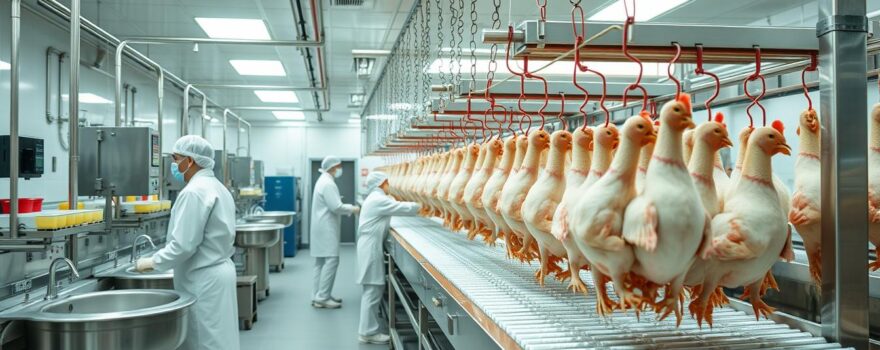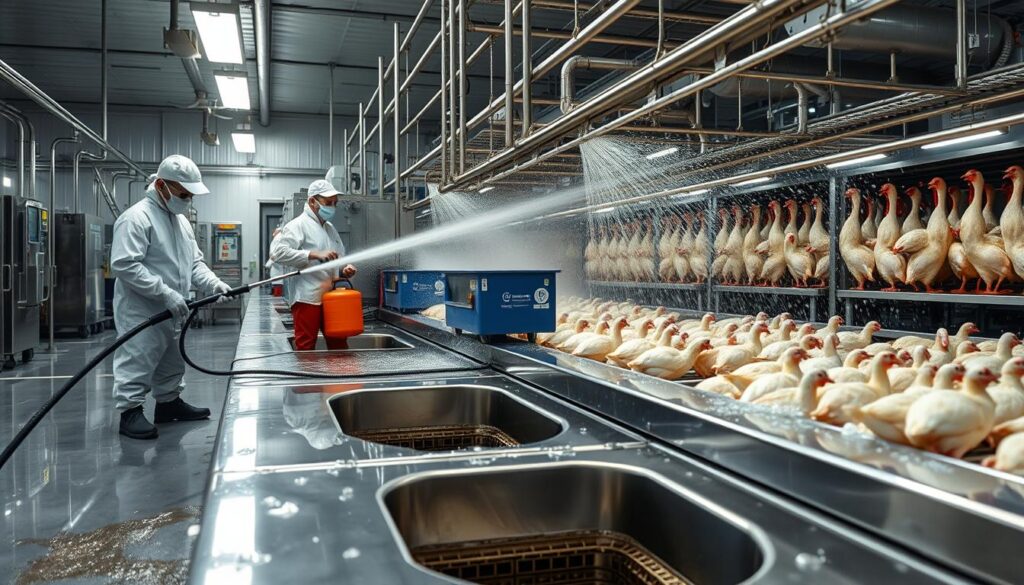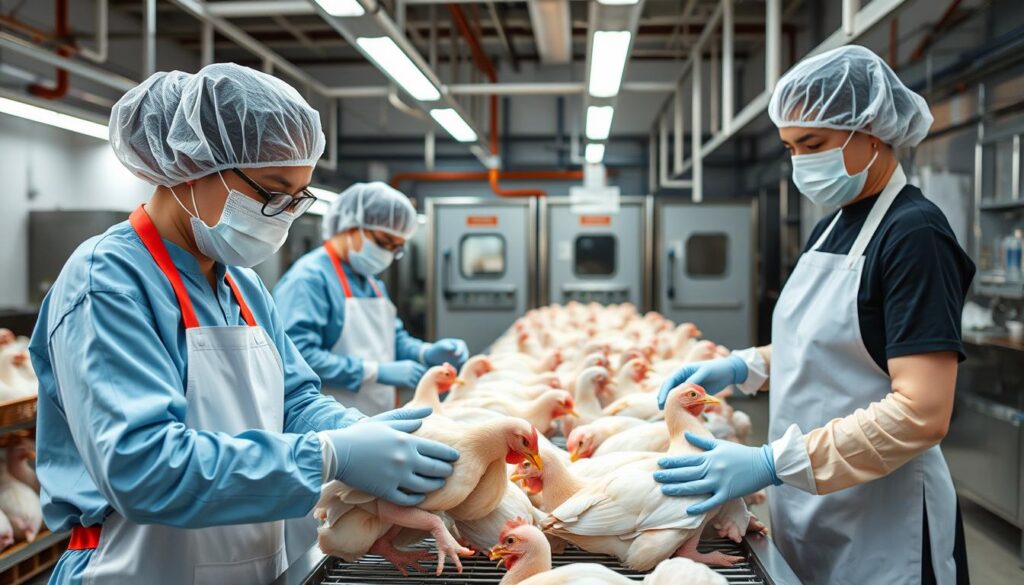
To make poultry meat better for consumers, it may be seasoned or marinated. Sometimes, parts are turned into ready-to-eat items like hotdogs or nuggets. The Occupational Safety and Health Administration (OSHA) knows the poultry industry faces many dangers. That’s why there are rules to help keep everyone safe and ensure quality.
Key Takeaways
- The Role of Hygiene in Broiler Chicken Processing Facilities is crucial for food safety and pathogen control.
- Proper sanitation procedures and cleaning protocols are essential for HACCP compliance and cross-contamination prevention.
- Antimicrobial interventions and worker hygiene practices are important to control the spread of foodborne pathogens.
- Adhering to poultry processing regulations set by USDA-FSIS and OSHA guidelines ensures safe operations.
- Maintaining high hygiene standards can increase the quality and shelf life of poultry products.
Introduction
Keeping hygiene high in poultry processing is key for food safety. It stops pathogen contamination and keeps poultry fresh longer. Poultry is very perishable and grows bacteria fast. This can make it spoil and even harm people’s health.
Overview of the Broiler Chicken Processing Lifecycle
The broiler chicken process includes many steps. These are receiving, slaughtering, scalding, and more. Each step must focus on cleanliness to keep food safe and meet Regulatory Compliance.
| Poultry Processing Step | Hygiene Considerations |
|---|---|
| Receiving | Inspect incoming birds for signs of disease or contamination, maintain clean holding areas. |
| Slaughtering and Stunning | Ensure proper sanitation of equipment and instruments, prevent cross-contamination. |
| Scalding and De-feathering | Maintain optimal water temperature and quality, regularly clean and disinfect equipment. |
| Evisceration and Washing | Implement effective carcass washing procedures, monitor for microbial contamination. |
| Chilling and Packaging | Maintain appropriate chilling temperatures, use sanitized packaging materials. |
Following strict The Role of Hygiene in Broiler Chicken Processing Facilities is vital. It protects Food Safety and Pathogen Control. It also makes sure we follow Regulatory Compliance.
The Role of Hygiene in Broiler Chicken Processing Facilities
Keeping facilities clean is key in broiler chicken processing. It’s all about food safety and controlling pathogens. Cleaning well stops the spread of harmful germs and keeps food fresh longer.
Freezing and storing in the freezer are big steps in controlling harmful bacteria. This stops harmful germs like Campylobacter and Salmonella from growing. Cleaning and disinfecting all contact surfaces is also vital to avoid contamination.
Workers must wash their hands and wear clean gear. Keeping different areas separate and cleaning often helps keep the place safe and clean.
“Hygiene is not just a recommendation, it’s a necessity in the poultry industry. The health and safety of consumers depend on the diligent implementation of cleaning and disinfection protocols at every stage of the processing cycle.”
By focusing on hygiene and following strict cleaning rules, facilities can keep food safe. This ensures that the chicken products are of high quality and safe for everyone to eat.
Key Poultry Processing Steps and Hygiene Considerations
The poultry processing industry fights against spoilage and harmful bacteria at every step. Keeping hygiene high at key steps is key to food safety and pathogen control. Let’s look at the main poultry processing steps and the hygiene considerations for each.
Receiving and Holding
When live birds arrive, it’s important to check them and keep them in a clean, airy area. This step helps avoid cross-contamination from the cages. The area must be cleaned and disinfected well to keep hygiene standards high.
Slaughtering and Stunning
The slaughtering and stunning steps need to be done in a clean place to stop pathogens from spreading. It’s vital to sanitize equipment and work areas to prevent cross-contamination.
Scalding and De-feathering
Scalding and de-feathering need careful hygiene to remove feathers and dirt. Cleaning and disinfecting the scalding tanks and de-feathering tools are key to food safety.
Evisceration and Washing
Evisceration, or removing organs, and washing the carcasses are critical for pathogen control. Cleaning and disinfecting the evisceration line and wash water are essential to stop harmful bacteria.
Chilling and Packaging
The last steps, chilling and packaging, must be done in a very clean environment. Keeping the right temperature and using clean packaging materials are crucial for food safety and longer shelf life.
By focusing on hygiene practices at every stage, the industry can reduce cross-contamination and pathogen proliferation. This ensures safe and quality poultry products.
| Processing Step | Hygiene Considerations |
|---|---|
| Receiving and Holding | Clean, well-ventilated holding area, Thorough cleaning and disinfection |
| Slaughtering and Stunning | Clean, hygienic environment, Proper sanitation of equipment and surfaces |
| Scalding and De-feathering | Regular cleaning and disinfection of scalding tanks and de-feathering equipment |
| Evisceration and Washing | Thorough cleaning and disinfection of evisceration line and wash water |
| Chilling and Packaging | Sanitized environment, Proper temperature control, Clean and disinfected packaging materials |
Major Occupational Hazards in Poultry Processing
The poultry processing industry is dangerous for workers. It exposes them to many health risks. The International Labour Organization (ILO) lists several hazards. These include physical dangers like noise and cold, and ergonomic issues like repetitive work.
Chemical and biological hazards are also big concerns. Workers face risks from dust, disinfectants, and harmful bacteria. Traumatic injuries and Musculoskeletal Disorders (MSDs) are common, especially in processing and packaging.
Occupational Hazards in Poultry Farming
Poultry farm workers face many dangers. These include infectious diseases and exposure to dust and toxic gases. They also risk physical injuries and hearing problems from loud noises.
Ergonomic issues can lead to musculoskeletal problems. There’s also a higher risk of cancer. These hazards affect workers’ health and well-being. It’s crucial to have strong safety measures and protect workers.
| Hazard Type | Examples |
|---|---|
| Physical Hazards | Noise, exposure to cold, vibration |
| Ergonomic Hazards | Manual and repetitive work, forceful exertion, awkward work positions, fast work pace |
| Chemical Hazards | Dust, chemicals from disinfectants, cleaning agents |
| Biological Hazards | Bacteria, viruses, fungi |
| Traumatic Injuries | Sprains, strains, cuts, burns |
| Musculoskeletal Disorders | Back pain, arm and hand pain |
Poultry processing and farming workers face many dangers. It’s vital to have strong safety measures and protect them. Training, personal protective equipment, and engineering controls can help reduce these risks. This ensures the well-being of this important workforce.
Regulations and Guidelines for Poultry Processing Facilities
The poultry processing industry follows strict rules to keep food safe and protect workers. The U.S. Department of Agriculture’s Food Safety and Inspection Service (USDA-FSIS) and the Occupational Safety and Health Administration (OSHA) are in charge.
USDA-FSIS Regulations
The USDA-FSIS makes sure facilities follow the Federal Meat Inspection Act and Poultry Products Inspection Act. These laws have important rules for poultry processing. Some key points include:
- Creating a Hazard Analysis Critical Control Point (HACCP) plan to manage food safety risks
- Having a detailed Sanitation Program for cleaning and disinfecting
- Following rules for temperature, handling, and packaging of poultry
- Doing regular checks and tests to make sure food safety rules are followed
OSHA Recommendations
OSHA also has safety guidelines for poultry processing to protect workers. These include:
- Offering good safety training and personal protective equipment (PPE) for everyone
- Making sure workers get enough breaks and job changes to avoid tiredness
- Putting in place good ways to control hazards, like machine guards and ergonomic workstations
- Doing safety checks often and fixing any problems right away
By following these Poultry Processing Regulations from USDA-FSIS and OSHA, facilities can keep food safe, workers healthy, and the environment protected.
Effective Cleaning and Disinfection Procedures
Keeping food safe and of good quality is key in broiler chicken processing. This means following strict Cleaning and Disinfection Procedures. These steps help get rid of health risks and stop harmful bacteria and mold from growing.
Removal of Organic Matter
The first step is to remove big pieces and dirt. This is done with high-pressure water and mops. Cleaning well makes surfaces ready for cleaning agents and disinfectants.
Detergent and Disinfectant Application
Next, Detergent and Disinfectant Application is crucial. Cleaning solutions are applied to surfaces. This helps get rid of dirt, grease, and other contaminants. The right amount of time is given for these solutions to work best.
Rinsing and Sanitation
Then, Rinsing and Sanitation comes last. Clean water is used to wash away dirt and leftover detergent. This makes surfaces ready for disinfection. Disinfection involves spraying surfaces with the right amount of disinfectant and waiting for it to work.
Good Cleaning and Disinfection Procedures are vital for fighting Biofilm Detection and Removal in poultry plants. Biofilms can hide harmful bacteria like Campylobacter and Salmonella. Using special tools and products can help remove these biofilms.

Having a strong Cleaning and Disinfection Procedures program is crucial. Regular checks and quality control are also important. This keeps the environment clean and ensures safe, quality chicken products.
Controlling Pathogenic and Spoilage Microorganisms
Keeping poultry products safe and of good quality is very important in the food industry. Microorganisms like Campylobacter, Salmonella, Listeria, and E. coli can be harmful. On the other hand, spoilage microorganisms like Pseudomonas can make the product taste bad. It’s key to keep everything clean and controlled to fight these microbes.
Campylobacter and Salmonella
Campylobacter and Salmonella are common causes of foodborne illnesses from poultry. To reduce their spread, it’s important to follow strict biosecurity, handle food carefully, and clean and disinfect well.
Listeria and E. coli
Listeria and E. coli are also dangers in poultry processing. Listeria likes cold, wet places, and E. coli can come from poor hygiene. Good sanitation and constant checks for these pathogens are needed to keep food safe.
Biofilm Detection and Removal
Biofilms are hard to clean and can harbor bacteria. Special tools and new cleaning methods are needed to find and remove biofilms. This stops them from causing ongoing contamination.
| Microorganism | Significance | Control Measures |
|---|---|---|
| Campylobacter | Leading cause of foodborne illness linked to poultry | Effective biosecurity, rigorous cleaning and disinfection |
| Salmonella | Prominent foodborne pathogen associated with poultry products | Strict sanitation protocols, monitoring for Salmonella spp. |
| Listeria | Capable of growing in cold, moist processing environments | Robust cleaning and disinfection programs, vigilant monitoring |
| E. coli | Indicator of poor hygiene and potential for cross-contamination | Emphasis on personal hygiene, effective sanitation practices |
By using strong pathogenic and spoilage microorganism control measures, food processors can make sure poultry products are safe and of high quality. This protects public health and keeps their brand strong.
Personal Hygiene and Worker Safety
In the poultry processing industry, keeping clean and safe is key. Employers must focus on safety, teaching workers how to stay safe. Washing hands often and wearing protective gear are musts for a clean and safe place to work.
Employers should hold safety training often. This helps workers know why safety rules are important. Giving workers breaks and changing their tasks can also lower injury and tiredness risks.
- Handwashing: Frequent and thorough handwashing with soap and water is critical to prevent the spread of pathogens and maintain personal hygiene.
- Personal Protective Equipment (PPE): The use of PPE, such as gloves, aprons, and safety glasses, protects workers from physical, chemical, and biological hazards.
- Safety Training: Weekly safety training sessions educate workers on best practices, hazard identification, and emergency procedures.
- Workstation Rotation: Rotating employees across different tasks helps to mitigate the risk of repetitive strain injuries and muscular fatigue.
- Breaks and Rest: Ensuring adequate breaks and rest periods for workers helps to maintain their physical and mental well-being, reducing the likelihood of accidents.
By building a strong safety culture and teaching workers about hygiene and safety, poultry plants can keep their workers safe. This helps everyone stay healthy and work well together.
| Occupational Hazard | Preventive Measure |
|---|---|
| Workplace Injuries | Install safety guards on machinery, implement maintenance protocols, and provide proper personal protective equipment. |
| Slip and Fall Accidents | Maintain clean and dry floors, use non-slip mats, and ensure proper footwear for workers. |
| Accidental Cuts | Train workers on proper knife handling techniques, provide cut-resistant gloves, and ensure well-maintained equipment. |
| Noise-Related Health Concerns | Implement noise control measures, such as sound-dampening enclosures and provide hearing protection for workers. |
| Biological Hazards Exposure | Enforce strict hygiene practices, provide appropriate PPE, and implement effective cleaning and disinfection protocols. |
| Musculoskeletal Disorders | Rotate workstations, adjust equipment to ergonomic standards, and provide training on proper lifting techniques. |
By focusing on hygiene and safety, poultry plants can make a better work place. This is good for workers and helps the whole operation run smoothly.

“Ensuring the safety and well-being of our workers is a fundamental responsibility in the poultry processing industry. We are committed to fostering a culture of safety that empowers our employees to take ownership of their personal hygiene and occupational health.”
Monitoring and Quality Assurance Practices
Keeping food safe and clean is key in chicken processing. Regular checks on cleaning and disinfection help spot any issues. This helps improve hygiene and save costs.
Testing for microbes is a big part of keeping food safe. Companies and labs test the food to make sure it’s safe. They check if it meets USDA standards for safety.
Key Quality Assurance Practices
- Comprehensive Hazard Analysis to identify and mitigate biological, chemical, and physical risks throughout the production process
- Meticulous Recordkeeping to aid in product traceability and quickly address any safety concerns
- Prompt Corrective Actions when critical limits are exceeded, such as adjusting processing conditions or conducting additional testing
- Rigorous Verification through independent audits, reviews, and testing to confirm the effectiveness of quality control measures
These steps, based on HACCP, are vital for keeping food safe and clean in chicken processing.
| Quality Control Measure | Objective | Key Considerations |
|---|---|---|
| Hazard Analysis | Identify and mitigate biological, chemical, and physical risks | Comprehensive assessment of potential hazards throughout the production process |
| Recordkeeping | Facilitate traceability and address safety concerns | Meticulous documentation of each production stage |
| Corrective Actions | Address deviations from critical limits | Adjustments in processing conditions, rerouting products, or conducting additional testing |
| Verification | Confirm the effectiveness of quality control measures | Independent reviews, audits, and testing |
“Maintaining proper temperature control throughout the supply chain is crucial for preventing the growth of harmful bacteria, posing a challenge due to fluctuations during transportation and storage.”
Keeping hygiene in broiler chicken processing at its best is key for quality, safety, and sustainability in poultry meat. The poultry industry has invested a lot in new technologies and science to make chicken safer. The USDA Food Safety and Inspection Service (FSIS) checks and tests regularly, showing these efforts are working well.
Proper handling and cooking chicken to 165°F (74°C) is the best way to avoid foodborne illness. This method kills all harmful bacteria on raw chicken. By following strict food safety rules, the poultry industry can keep providing safe, affordable protein for everyone.
The poultry industry faces challenges like water usage. But, keeping up with hygiene and sanitation is crucial. It helps the industry improve and stay known for safe, healthy, and eco-friendly food.